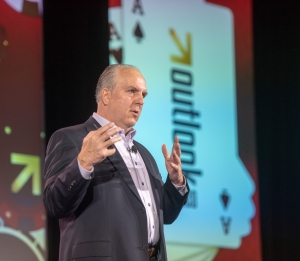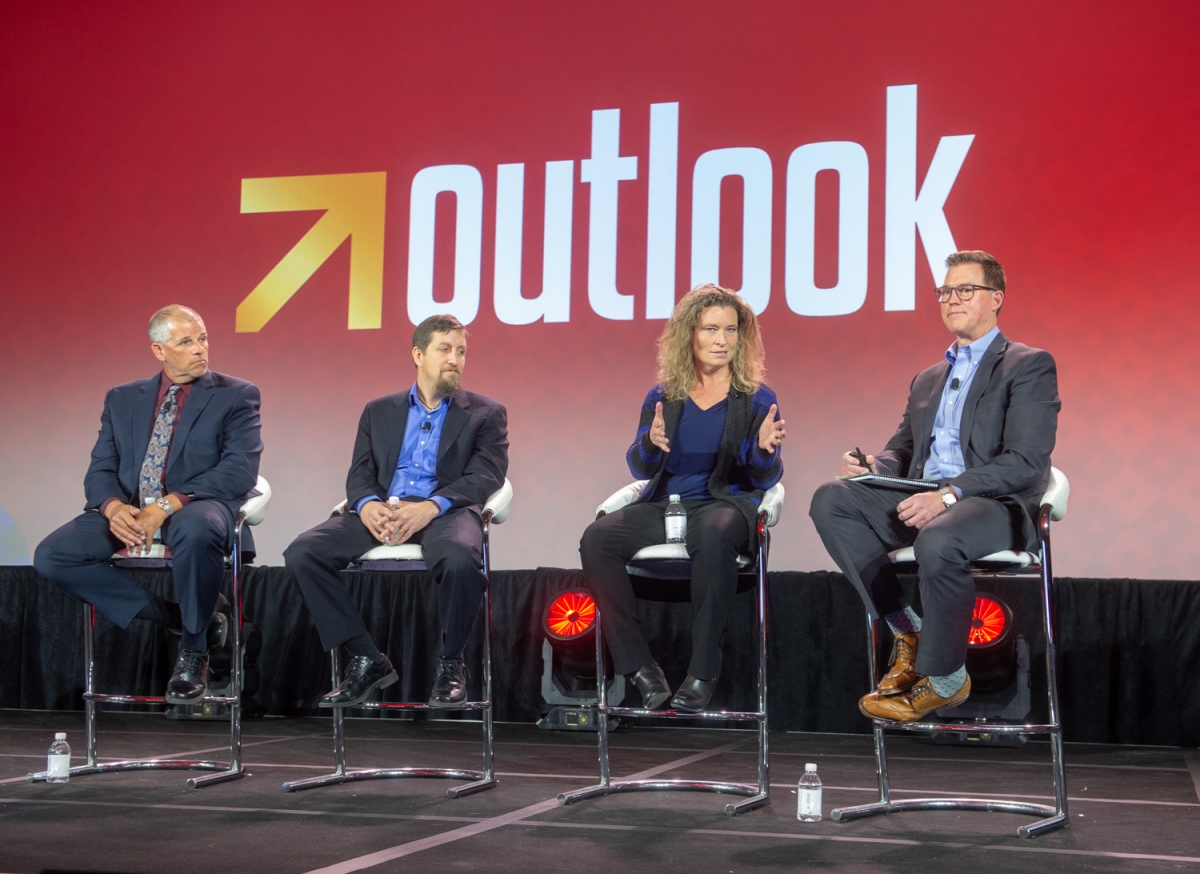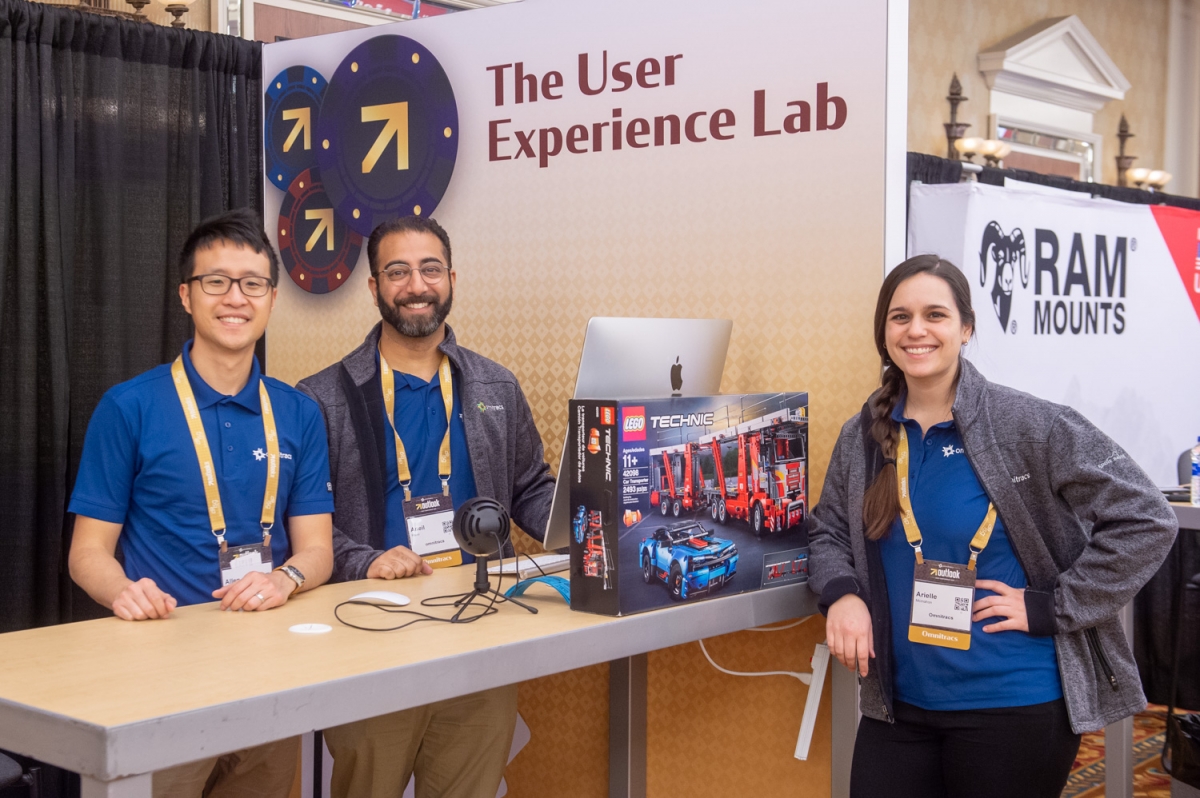
“The potential I saw before I got here is greater than I realized. Every door you open has ten more behind it.”
- Omnitracs CEO Ray Greer, Outlook 2020 Opening General Session
Omnitracs Outlook 2020 is officially here, and we couldn’t be more thrilled to welcome our 900+ guests from around the U.S. and Canada to Caesars Palace in Las Vegas. Last night, we hosted our attendees for a fun-filled welcome reception, complete with dinner and cocktails and non-stop entertainment from Rat Pack singers, magicians, and celebrity impersonators.
The world is changing — and we’re changing with it
Omnitracs CEO Ray Greer welcomed our guests at our Opening General Session this morning with an emphasis on our consistent evolution-focused mentality. In 2018 — Greer’s first year with Omnitracs — we reprioritized by focusing on reliability, improved features, and innovation. In 2019, we saw 9% customer growth, and we built out our first generation of Omnitracs One for Enterprise Grade customers, which we delivered on in December 2019 with 15,000 vehicles now running on that platform.
Greer highlighted the MCP outage that occurred in November 2019, and he reemphasized Omnitracs’ commitment to transparency. This was most showcased in both our escalation of the event and our around-the-clock commitment that led to a quick and speedy return to functionality.
Looking toward the future, Greer stated we have done a tremendous amount to build a culture of innovation and talented teams by bringing on essential OEM executives and data scientists. Moving into 2020 and the future, we are aiming to migrate from a monolithic solution to a true-cloud platform in order to become more data-driven and software focused. Greer said, “There is a very natural tension between supporting and sustaining old technology and innovating with new. Somewhere, we have to find the balance between the two.”
At Omnitracs, we want to create a platform that enables everyone, with a special focus on convenience for the drivers who make so much possible. We look forward to doing just that in 2020 and beyond!
Keeping up with compliance
Following our Opening Session, we held Over-the-Road and Last Mile Super Sessions. In our Over-the-Road Super Session, our panel of industry leaders focused on key compliance and regulatory topics.
This panel, led by Omnitracs Vice President of Regulatory Affairs Mike Ahart, consisted of:
- Kerri Wirachowsky, Director of Roadside Inspection Program at the CVSA
- Joe DeLorenzo, Acting Associate Administrator for Enforcement at the FMCSA
- Mike Millian, President of Private Motor Truck Council of Canada
With the Canadian ELD Mandate less than a year and a half away, Millian said the biggest issue that will face manufacturers and carriers will be to make sure they have sufficient time to switch over — especially given that Canadian ELDs must have third-party certification. With testing procedures still underway, a market-certifiable device will likely come in June 2020.
The FMCSA’s change to Hours of Service regulations in the industry has been a hot topic, and Wirachowsky emphasized that while most of the improvements have been making sense, modifications still need to be made. In conjunction with that statement, DeLorenzo stated that the FMCSA is looking through the extensive helpful feedback they’ve received to make decisions about a final rule in order to provide flexibility to those rules and use that flexibility to improve safety.
With the U.S. ELD compliance requirement now in full effect, DeLorenzo shared that glitches can still happen, and that’s why it’s imperative that drivers are trained on how to utilize their devices. This is especially critical from a law enforcement standpoint, Wirachowsky stated, as roadside inspectors still encounter drivers who are not following proper protocol. That’s why both the FMCSA and the CVSA are working closely to make sure they are always consistent with their messaging.
Increased traffic, Amazon’s heavy customer-delivery influence, and enhanced infrastructure has made it so that the industry has changed substantially in the past two decades. With the pace technology is developing, a new transportation reauthorization is on the rise.
Leveraging data in the last mile
David Julian, Director of Distribution with Breakthru Beverage, centered this session on the importance of investing time and strategy into data for your business. The proliferation of data is overwhelming, and the challenge lies in converting this data into actionable insights.
Utilizing KPIs and metrics is critical, but when we focus on measuring everything, we’re unable to get other things done. As Julian says, “We need to be able to leverage that data to assist in coaching the drivers, routers, and dispatchers on how we go about improving. Oftentimes when we dig into metrics, we discover trends.”
Here are a few best practices to keep top of mind:
- Clearly define the strategy, process, and ownership associated with each metric you introduce.
- Ensure your metrics are balanced and focus on safety, compliance, quality, productivity, and utilization.
- Start simple and introduce more complicated metrics, like on-time delivery and route duration, as you go along.
- Don’t let data quality issues be an excuse — fight for process consistency, and filter out the dirty data to see true trends.
Optimizing cloud benefits and strategic planning with some of our top customers
J&B Group — a Minnesota-based producer and distributor of quality food products — has been working with Omnitracs to achieve their guidelines for success since 1999. When they sought to update their devices to ensure compliancy with ELD regulations in 2018, they did extensive research on over a dozen vendors. They turned to Omnitracs because of our functionality capabilities, comparable pricing, and enhanced connectivity. As presenter Sarah Serie stated, J&B Group’s cloud environment means they have substantial access to data that is helping them make better business decisions and improve driving behaviors.
Carolyn Boom, Director of Route Optimization with US Foods, has worked with Omnitracs Roadnet since 2012. She focused her session on how strategic planning can greatly improve customer service, as the most common question amongst customers is "Where's my truck?" As such, giving these customers a better understanding of when their orders arrive is key. Strategic planning can also help you save on bottom-line costs, grow business profitability, and reduce your carbon footprint. From 2017 to 2018, US Foods saw a reduction in over 10 million miles driven with Omnitracs Strategic Planner.
Using data to change an industry: Sneak peek at the Omnitracs Innovation Lab
Omnitracs Vice President and General Manager of Strategic Initiatives Mic Yariv hosted a special sneak peek catered to over-the-road professionals.
The Omnitracs Innovation Lab is working to address some of the toughest challenges faced by our customers and the transportation industry today. Research, projects, and prototypes to date include analyzing parking deserts, location intelligence, and near real-time micro-weather alerts. Omnitracs Innovation Lab is focused specifically on the problems that are impactful, pervasive, and unsolved.
Here are a few key takeaways we’re excited to share with you:
- Weather data today is very broad (along the lines of 30% chance of rain) — traditional weather forecasting infrastructure doesn’t account for what drivers need. Omnitracs is working on sourcing weather info from hyper-local sources, such as road cameras and microwave signals from cell towers.
- Leveraging geofencing and nearly 7 million data points, Omnitracs is also working on near real-time location data and identifying parking deserts to inform day planning for drivers.
- We have gathered location intelligence on close to 7 million locations, and we have also leveraged exactly 6.69 million data points.
Yariv said, “Our idea is we can take all of this data, aggregate it into one place, and have very rich content about the place your driver is going to service.”
Diversify your driver pool with the right recruiting strategy
When it comes to diversifying your driver pool beyond the status quo, Director of Marketing with CPC Logistics Tom Bickel insists in this breakout session that the narrative changes every day.
Some of the leading job-recruitment companies are attempting to reshuffle, but they more than likely will be torpedoed by the biggest names in recruitment. Search engines have been changing the game, and it has been imperative to learn everything we can about how search engines work and what is needed to make them happy. In the search engine game, you’re constantly thinking of ways to get your data in front of people and optimized. With 65-75% of job searches beginning on Google, keeping the leading search engine in mind should be top of mind.
Here are some key recruiting takeaways:
- Google has put a lot of emphasis on the speed of your website. If you’re presenting your data in a mobile-friendly fashion, Google will show your results more frequently.
- It’s important you make your content very light and mobile friendly. You can do this with a content management system that will give you that built-in optimization.
- Offer a referral program, as this is often the most effective recruiting tool. In your recruiting messaging, aim to be as relatable and open as you can be.
Emphasize real data to escape unfair insurance and legislative cycles
Steve Setliff, partner at Setliff Law, kicked off the session by discussing how attorneys have demonstrated a pattern of placing incident blame on truck drivers — and their respective companies — by taking advantage of the Reptile Theory. To help, Setliff explained that it is an absolute must for fleets to make their company look as safe as possible from the outside via social media presence, driver training, and low CSA scores. “We make it easy for lawyers to prove we are bad actors,” Setliff said. “The best way to survive a gunshot wound is to not get shot, and the best way to survive the environment we’re living in now is to take some perspective steps to avoid the problem.”
Director of H.S.S.E and HR at Payne Trucking Christopher Haney followed with a shocking statistic: In 2019, 790 carriers closed their doors due to high insurance premiums. Haney suggested taking the time to talk to drivers about the importance of recording data and deciding on a strategy in order to avoid this. “Pay attention to every aspect of every violation — from citation to fatality,” Haney said. “Pull as much raw data as you can, information is your friend in these cases.”
Meeting customer expectations while controlling costs
Drew Reiss, a leading delivery operations director, kicked off one of our final breakout sessions of the day with a focus on customer segmentation, which is the idea that our customers are different, and we should treat them as such. When your customers are unsegmented, you have priority accounts under serviced and non-priority accounts over serviced. To prioritize the right customers, you must determine what essential criteria for your business is in place to determine which accounts are important ones.
Service level is becoming more and more important, and variances in customer experiences are noticeable. Customer experience has overtaken product and price as the key brand differentiator. In 2013, 36% of companies were competing primarily on the basis of customer experience. Today, that number has rocketed to 67%. Customer feedback is the most important service level KPI. “You don’t know what your service is unless you ask,” Reiss said.
Here is Reiss’ guide to delivering world-class customer service:
- Track your service level with customer feedback, and break down your feedback scores by detractors, passives, and promoters. Promoters love your service, passives are okay with your service, and detractors are not happy with your service.
- Master on-time and in-full deliveries.
- Enhance the customer experience with a preferred time window, delivery transparency, and a set driver-customer routine.
In addition to attending today's sessions, customers frequently visited our exhibitor hall, which was full of exhibits of Omnitracs product and-industry-related stations. Our Dr. ELD station and Smart Bar have been some of our most popular stations so far, with customers getting all the tech and ELD-related answers they've been searching for. Our User Experience Lab best showcases how we've catered this year's conference to focus on innovation and hands-on customer experiences.
That’s a wrap for our first Omnitracs Outlook 2020 recap! Tonight, our customers are heading to OMNIA Nightclub to enjoy an evening of dinner, cocktails, and networking. Be sure to check back in tomorrow evening for our full day 2 recap. Happy conferencing!



